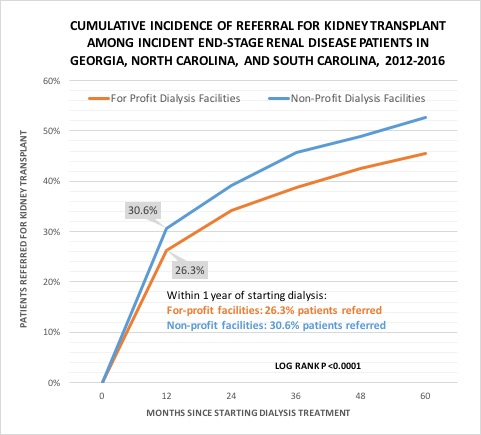Dialysis Facility Profit Status and Referral for Kidney Transplantation
1Emory University School of Medicine, Atlanta, GA, 2Kaiser Permanente Georgia, Atlanta, GA
Meeting: 2019 American Transplant Congress
Abstract number: 214
Keywords: Allocation, Kidney, Kidney transplantation
Session Information
Session Name: Concurrent Session: Kidney Deceased Donor Allocation II
Session Type: Concurrent Session
Date: Monday, June 3, 2019
Session Time: 2:30pm-4:00pm
 Presentation Time: 3:06pm-3:18pm
Presentation Time: 3:06pm-3:18pm
Location: Ballroom B
*Purpose: Patients receiving dialysis treatment in for-profit dialysis facilities have historically lower rates of kidney transplantation (KT) compared to non-profit facilities, but the impact of dialysis facility profit status on referral for KT evaluation is unknown because these data are not collected in national surveillance data. This study is the first to examine the impact of dialysis facility profit status on referral for KT evaluation at a transplant center among incident end-stage renal disease (ESRD) patients in Georgia, North Carolina, and South Carolina (ESRD Network 6), the ESRD network with the lowest KT rates in the United States.
*Methods: We examined United States Renal Data System (USRDS) data from a cohort of 27,076 adult ESRD patients treated at 645 dialysis facilities from January 2012 to December 2015, followed through December 2016, merged with KT referral data collected from all nine transplant centers in ESRD Network 6. We excluded 79 patients (0.3%) and 52 dialysis facilities (8.0%) with missing profit status information from analyses. Profit status was defined as either for-profit or non-profit in USRDS. We used multivariable Cox hazards models to examine referral for KT evaluation within 1 year of starting dialysis across facility profit status.
*Results: We included 26,997 incident ESRD patients, 22,327 (82.7%) received dialysis in 481 for-profit facilities and 4,670 (17.3%) received dialysis in 112 non-profit facilities. For-profit facilities referred significantly fewer of their patients than non-profit facilities (26.3% vs 30.6%; p<0.01) within 1 year of initiating dialysis. Cumulative incidence data (Figure 1) exhibits similar trends for five years from start of dialysis treatment. In multivariable analyses, patients receiving dialysis in non-profit facilities were more likely to be referred for evaluation than patients in for-profit facilities (HR: 1.19; 95% CI: 1.12-1.26).
*Conclusions: Patients receiving dialysis treatment in for-profit facilities in Georgia, North Carolina, and South Carolina were significantly less likely to be referred for evaluation at a transplant center than patients in a non-profit facility. Further research is needed to determine the potential health system incentives that may be applied to reduce this disparity.
To cite this abstract in AMA style:
Walker ER, McPherson LJ, Gander JC, Pastan S, Patzer RE. Dialysis Facility Profit Status and Referral for Kidney Transplantation [abstract]. Am J Transplant. 2019; 19 (suppl 3). https://atcmeetingabstracts.com/abstract/dialysis-facility-profit-status-and-referral-for-kidney-transplantation/. Accessed December 20, 2025.« Back to 2019 American Transplant Congress

